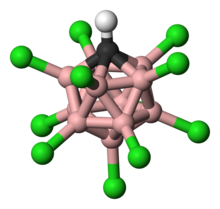
Back حمض الكربوران Arabic Карбаранавая кіслата Byelorussian Карбаранавая кісьля BE-X-OLD Карборанова киселина Bulgarian کربوران اسید Persian Karboránsav Hungarian カルボラン酸 Japanese 카보레인산 Korean Kwas karboranowy Polish Ácido carborano Portuguese
 | |
| Identifiers | |
|---|---|
3D model (JSmol)
|
|
| |
| |
Except where otherwise noted, data are given for materials in their standard state (at 25 °C [77 °F], 100 kPa).
| |
Carborane acids H(CXB
11Y
5Z
6) (X, Y, Z = H, Alk, F, Cl, Br, CF3) are a class of superacids,[1] some of which are estimated to be at least one million times stronger than 100% pure sulfuric acid in terms of their Hammett acidity function values (H0 ≤ –18) and possess computed pKa values well below –20, establishing them as some of the strongest known Brønsted acids.[2][3][4] The best-studied example is the highly chlorinated derivative H(CHB
11Cl
11). The acidity of H(CHB
11Cl
11) was found to vastly exceed that of triflic acid, CF
3SO
3H, and bistriflimide, (CF
3SO
2)
2NH, compounds previously regarded as the strongest isolable acids.
Their high acidities stem from the extensive delocalization of their conjugate bases, carboranate anions (CXB11Y5Z6−), which are usually further stabilized by electronegative groups like Cl, F, and CF3. Due to the lack of oxidizing properties and the exceptionally low nucleophilicity and high stability of their conjugate bases, they are the only superacids known to protonate C60 fullerene without decomposing it.[5][6] Additionally, they form stable, isolable salts with protonated benzene, C6H7+, the parent compound of the Wheland intermediates encountered in electrophilic aromatic substitution reactions.
The fluorinated carborane acid, H(CHB
11F
11), is even stronger than chlorinated carborane acid. It is able to protonate butane to form tert-butyl cation at room temperature and is the only known acid to protonate carbon dioxide to give the bridged cation, [H(CO
2)
2]+
, making it possibly the strongest known acid. In particular, CO2 does not undergo observable protonation when treated with the mixed superacids HF-SbF5 or HSO3F-SbF5.[7][8][9]

As a class, the carborane acids form the most acidic group of well-defined, isolable substances known, far more acidic than previously known single-component strong acids like triflic acid or perchloric acid. In certain cases, like the nearly perhalogenated derivatives mentioned above, their acidities rival (and possibly exceed) those of the traditional mixed Lewis-Brønsted superacids like magic acid and fluoroantimonic acid. (However, a head-to-head comparison has not been possible thus far, due to the lack of a measure of acidity that is suitable for both classes of acids: pKa values are ill-defined for the chemically complex mixed acids while H0 values cannot be measured for the very high melting carborane acids).
- ^ Note that the image the acidic proton is not the one bonded to the carborane but that it is the counterion not displayed.
- ^ Olah, G. A.; Prakash, G. K. S.; Sommer, J.; Molnar, A. (2009). Superacid Chemistry (2nd ed.). Wiley. p. 41. ISBN 978-0-471-59668-4.
- ^ That is, were it liquid, the protonating ability of a neat sample of the carborane superacid, as measured by the activity of H+, would be a million times higher than that of 100% sulfuric acid.
- ^ Cite error: The named reference
:0was invoked but never defined (see the help page). - ^ Juhasz, M.; Hoffmann, S.; Stoyanov, E.; Kim, K.-C.; Reed, C. A. (2004). "The Strongest Isolable Acid". Angewandte Chemie International Edition. 43 (40): 5352–5355. doi:10.1002/anie.200460005. PMID 15468064.
- ^ Cite error: The named reference
Reed2005was invoked but never defined (see the help page). - ^ Nava Matthew (2013). "The Strongest Brønsted Acid: Protonation of Alkanes by H(CHB11F11) at Room Temperature". Angewandte Chemie International Edition. 53 (4): 1131–1134. doi:10.1002/anie.201308586. PMC 4993161. PMID 24339386.
- ^ Reed, Christopher A. (2013). "Myths about the proton. The nature of H+ in condensed media". Accounts of Chemical Research. 46 (11): 2567–75. doi:10.1021/ar400064q. PMC 3833890. PMID 23875729.
- ^ Cummings, Steven; Hratchian, Hrant P.; Reed, Christopher A. (2016-01-22). "The Strongest Acid: Protonation of Carbon Dioxide". Angewandte Chemie International Edition. 55 (4): 1382–1386. doi:10.1002/anie.201509425. ISSN 1521-3773. PMID 26663640. S2CID 2409194.